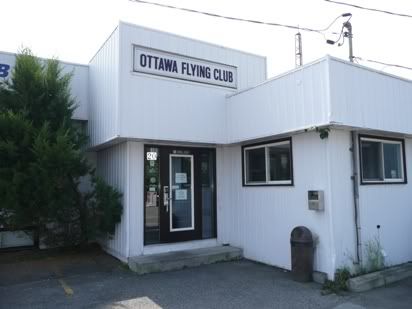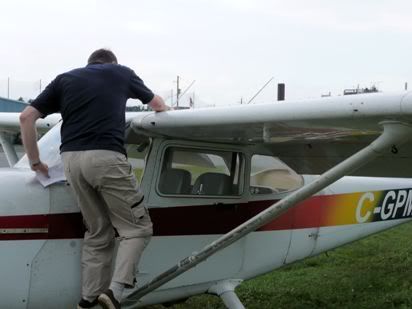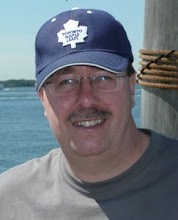I arrived at Ottawa Flying Club about half an hour beforehand. OFC is based at Ottawa International Airport, but at one end of the airport (accessed by a different access road) and with what is in effect, its own runway.

I checked in with reception and was introduced to my instructor, an affable guy called Ken Wright. Ken started with the dreaded words……’ hasn’t anyone been in touch with you?’. Anticipating disaster or more bureaucratic hurdles, he went on to say that the C172 I had booked (C-GCOH) was in the workshops and that there wasn’t another C172 available just now. I patiently asked him why CGCOH was in the workshops and what they could do about a checkride today. He explained that C-GCOH was in purely to have a new starter arm fitted and would be ready by 17:00 latest that day. We could either postpone the checkride until then or he could try to scare up another C172. I went for the latter option as the sky was starting to look menacing with possible TCU forecast as the afternoon wore on.

He came back and found that we could do a checkride in a C172 at about 14:00. I agreed to this and hung around chatting until I saw the plane taxi back in at the promised time.
Ken had a look at my logbook and seemed happy with my experience and currency and asked ‘So what do you want to do?’. I replied that it was more a question for him as he was the guy the club expected to be happy about me as I was planning on taking one of their C172’s away for four days flying in Canada and the USA. He thought about this and decided ‘OK, let’s go do a few circuits’ – my kind of guy!

We talked about local radio, arrival and departure differences. Being based at a busy national and international airport makes a bit of a difference, although not actually much different from Gloucester (where I am based) as it turned out. We booked out and were allocated a squawk. I checked out the C172. Well, it was certainly well worn, with lots of bare patches in the paint and pretty scruffy on the inside, but mechanically sound I was told. I was assured that C-GCOH was much tidier.
We started up called Ottawa Ground for clearance and taxied the short distance to the hold for runway 22 and did the power checks. All went well as we switched to Ottawa Tower and were given permission to ‘line up and wait’. I read this back and Ken was surprised as apparently ‘line up and wait’ is ‘new’ terminology in Canada as was the requirement to read it back. I explained this was standard in the UK and would probably have been confused by any other terminology. So again, it seemed likely to me that the radio work would be the hardest part of the trip!
We powered up and took off smoothly with circuits to the right. All circuits on this GA runway are to the north west. You have to be a bit careful in USA and Canada as some of the plates (indeed the local area map for Toronto / Ottawa) are NOT aligned with N/S up – so holding the map upright may be with grid north and the grid lines pointing diagonally – I found this disconcerting!
Ken pointed out the local turning points for circuits. While doing circuits I asked him about the C172 ‘rule’ that didn’t allow side-slipping with flaps. He was dismissive and said the blanking effect on the elevators only lead to a bit of nodding and that side-slipping was fine – suits me!
The first circuit was OK. Oddly though on the flare, I over-controlled it a bit and twice ballooned slightly, although landed OK in the end. I apologised for the somewhat hesitant landing but Ken was fine about it as I vowed to nail it the next time.

Basically, the next three circuits were fine as we landed off the fourth circuit.
I taxied back and followed the OFC checklist. I noted with interest the OFC insistence on doing a magneto ‘dead-cut check’ immediately before shutdown. This I did and very nearly turned the mags back through both onto start again. He pointed out that that was how the starter arm got sheared in the first place! Yeah – I can see that! I did ask why they did this ‘dead cut’ check as this was the first I had seen of it in training. I never cease to be amazed at how procedures vary and how one particular school may have a ‘bee in its bonnet’ about one aspect that another doesn’t much care about etc. Suffice to say that it is highly likely that I will ‘forget’ to do the dead cut check when I am renting the plane rather than risk a wrecked starter arm or motor!
At the debrief, I asked Ken about Ottawa departure and arrival procedures, but he said they would route me as they required and were not frantic about using published VRP’s, indeed they would often use ‘local-knowledge’ VRP’s (which is what I was afraid of).
Ken signed me off for hire and asked about our planned route. Apparently a ‘posse’ of them had earlier been out to the west coast of the USA and back. He thought we would have a great time on our planned route. He also emphasised that our hire plane, C-GCOH had the standard tanks, although it was an excellent weight-lifter (he said eyeing me at 210 lbs and Dan at 250 lbs). I replied that I knew this from the published W&B sheet and was strictly limiting myself to no leg longer than three hours, which would leave a pone hour reserve. He confirmed that this was the rule they used as well.
Well, he was happy and so was I. He did confide that the head mechanic working on C-GCOH had asked him about us and seemed worried about ‘some new guys from the UK taking the plane away’ – apparently he replied that he was the instructor and that if he said we were OK, then we were. Nice of him I thought.

We had a quick look at the now assembled and ready for service C-GCOH. It did at least have all of the paint on all of the surfaces I would have expected. The inside was tidier, but did have several yellow notices referring to U/S equipment. It was a basic VFR fit with two functioning VOR (but a U/S glide-slope). The pilot-side door would not hold on the latch and had to be closed and latched from the inside using the passenger door. Other than that, I couldn’t see any other ‘foibles’.
So we left OFC for a quick tour of the Ottawa War Museum and a restrained BBQ and a few beers back at Dan’s place.
